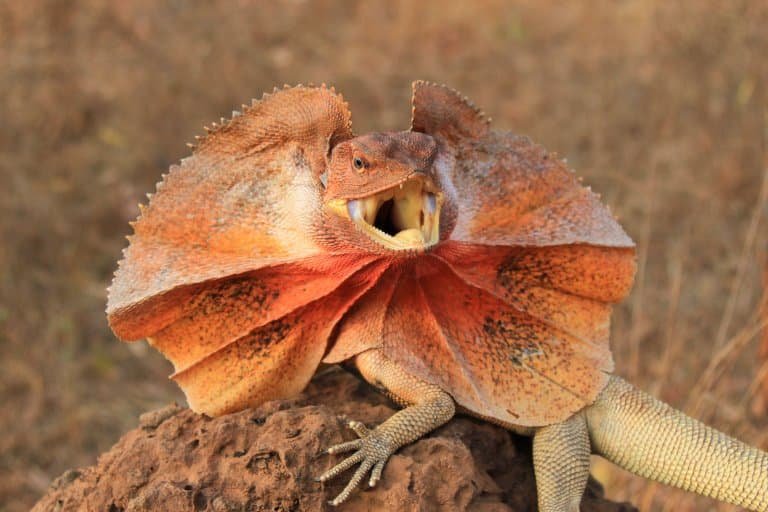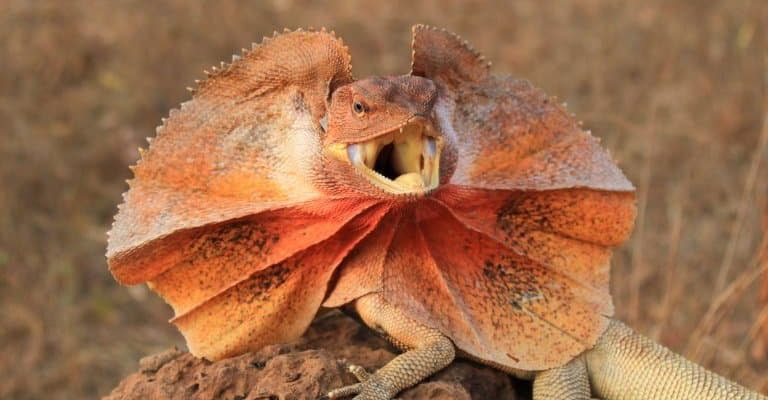
So, what’s the deal with these frilled lizards? Well, here’s the thing: their most distinctive feature is their impressive frill—a collar of skin that can be extended around their neck. This frill is not just for show; it plays a vital role in their survival. In this article, we’re going to explore ten fascinating facts about the frilled lizard that will give you a whole new appreciation for these quirky reptiles. Grab your favorite drink, and let’s dive in!
1. The Frill: A Stunning Defense Mechanism
The frilled lizard’s most striking feature, the frill, serves a purpose beyond aesthetic appeal. When threatened, it can inflate this frill to create a larger appearance. Imagine puffing up to look bigger and more intimidating—it’s like wearing an elaborate, colorful cape! This display can scare off potential predators like snakes and birds of prey, giving the frilled lizard a fighting chance to escape.
The frill isn’t just about size; it’s also about signaling. When a frilled lizard feels threatened, it engages in a theatrical display that includes head bobbing and opening its mouth wide. This dance of sorts can be enough to make a predator think twice before approaching. It’s nature’s way of saying, “Not today!”
2. Master of Disguise: Camouflage Skills
Frilled lizards are more than just dramatic; they’re also skilled at blending into their environment. These creatures have skin colors that range from brown to gray, enabling them to camouflage effectively among the trees and foliage of their native Australian forests. This ability helps them escape the notice of predators while they hunt for insects.
You might wonder how they become so adept at this. Well, lizards are cold-blooded, meaning their body temperature is regulated by the environment. By remaining still and relying on their natural colors, they can avoid detection until it’s time to reveal their true self—the vibrant frill!
3. Their Unique Habitat: Rainforests and Woodlands
Frilled lizards prefer dense tropical rainforests and woodlands, where the humidity is high and food sources are abundant. This habitat provides them with ample opportunities to find insects, which make up the majority of their diet. They thrive among the branches, often seen basking in the sun or communicating with others from tree limbs.
You might think that living in trees can be a bit tricky. However, frilled lizards are excellent climbers. They have long limbs and sharp claws that help them navigate their arboreal environment. It’s like they’re built for parkour in the treetops!
4. A Brief but Fascinating Life Cycle
Frilled lizards have a relatively short lifespan, usually living around 10 to 20 years in the wild. Once they reach adulthood, they can grow up to about 3 feet long, including their frill. Female frilled lizards typically lay eggs—around 8 to 23 at a time—in sandy soils or leaf litter. The eggs take about 60 to 70 days to incubate before hatching, which is quite a wait for a little lizard!
During the first few months, these hatchlings are vulnerable and rely on their camouflage skills to survive. As they grow, they start to develop their frills, marking the beginning of their transformation into the impressive creatures we know.
5. Not Just About Looks: Social Interaction
Frilled lizards engage in social interactions that go beyond intimidating displays. They communicate using body language and vocalizations. For instance, when a frill is fully extended, it signals readiness to battle another male for territory or mates. This display isn’t just for show; it’s a critical part of their social structure.
Interestingly, frilled lizards also participate in non-aggressive behaviors, such as grooming. They’ll rub against each other or lick one another’s skin—a bonding ritual that helps maintain social ties in their community.
6. A Carnivore’s Diet: What They Eat
Frilled lizards are carnivorous, primarily feeding on insects. Their diet includes ants, beetles, caterpillars, and other small invertebrates. Here’s a fun fact: they use their keen eyesight to spot food from a distance, making them excellent hunters. Imagine a tiny predator lurking in the trees, waiting for the perfect moment to strike!
During feeding, they’ll often climb down from their perches to catch prey. Their quick reflexes and agile bodies make them efficient hunters, ensuring they get enough to eat in their lush environments.
7. Their Role in the Ecosystem
Like many reptiles, frilled lizards play an important role in their ecosystem. By controlling insect populations, they help maintain a balance in their environment. More insects can lead to less healthy foliage, so these little hunters contribute to the overall health of their habitats.
Additionally, as prey for larger animals like birds of prey and snakes, frilled lizards are part of the food chain. This interconnected web of life is vital for maintaining biodiversity and ensuring the survival of many species.
8. Frilled Lizards in Culture and Media
Frilled lizards have made their mark not only in nature but also in popular culture. They often appear in documentaries, nature shows, and even as characters in animated films. Their unique appearance and behaviors make them a favorite among filmmakers and wildlife enthusiasts alike.
In Australia, where they’re commonly found, these lizards are celebrated as part of the natural heritage. They’ve inspired artists and storytellers, highlighting their significance beyond just being fascinating creatures.
9. Conservation Status: Protecting the Frilled Lizard
Currently, the frilled lizard is classified as a species of least concern, meaning they aren’t facing immediate extinction. However, habitat destruction due to logging and land development poses a risk to their populations. It’s crucial to protect their rainforest habitats to ensure that these remarkable lizards continue to thrive.
Conservation efforts, such as creating protected areas and promoting sustainable land use, are steps toward securing their future. By understanding the importance of these lizards, we can better advocate for their protection in the wild.
10. A Unique Pet Choice: Keeping Frilled Lizards
For reptile enthusiasts, frilled lizards can make fascinating pets. Their striking appearance and unique behaviors can be captivating for anyone willing to care for them. However, it’s essential to understand their specific needs, including appropriate habitat, diet, and temperature requirements.
If you’re considering adopting one, make sure to do your research. They require a spacious terrarium, a varied diet, and lots of climbing opportunities. With proper care, these lizards can live long, healthy lives and bring a touch of the wild into your home.
In conclusion, the frilled lizard isn’t just another reptile; it’s a symbol of the wonders of evolution and adaptability. From their striking frills and social behaviors to their role in the ecosystem, there’s so much to appreciate about these creatures. Whether you’re a nature lover, a budding herpetologist, or just curious about unique wildlife, the frilled lizard is sure to fascinate and inspire.

